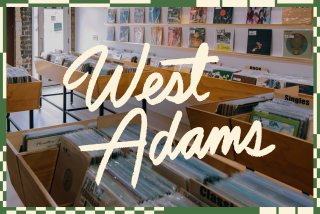Pseudo-Euro Village Falls Short of Quaint : Design: New shopping center in Bonsall was built to embrace the car, rather than shunting vehicles to distant parking lots.
- Share via
SAN DIEGO — In rural and urban areas alike, the automobile drives the design of California shopping centers. Urban centers stow cars in multilevel lots that integrate poorly with nearby architecture. Shoppers leave their cars behind to experience these malls on foot. The most visible features of suburban malls are sprawling parking lots, where, again, shoppers abandon cars for a pedestrian shopping experience.
This was the problem that once again confronted developers and architects of River Village, a 24-acre, $27-million mixed-use center in Bonsall that opened in September. They believe they have created something new: a center that acknowledges--no, embraces--the automobile.
Streets that wind through 17 buildings include rows of parking slots to allow shoppers to park in front of shops instead of in distant lots.
“People out in Bonsall will pick up a bale of hay in their Mercedes,” said Del Mar architect Andrew Herbruck, explaining the reluctance of locals in this upscale rural small town to venture far from their cars to shop.
“The automobile is like a shopping cart there,” said Herbruck, who came up with the layout and basic architectural theme of River Village before the design was more fully realized by La Jolla architect Mark Lee Christopher and executed in working drawings by Architects/Larson/Carpenter of San Diego.
Celebrating the car--instead of ignoring it--is an interesting idea, but one that only partly succeeds at River Village, a pseudo-Spanish-style enclave designed to resemble a quaint village built over many years.
Situated at Mission Avenue and Pala Road, about 10 miles northeast of Oceanside, River Village is seen by the developers as a new town center for Bonsall, and it has many of the appropriate traits.
There is a “Main Street” and a circular, central intersection. Nearby is a plaza with a tower that is the equivalent of a Medieval village’s church steeple.
River Village has fast food, but it also has carefully chosen specialty restaurants. A designer market gives shoppers in this town of 13,772 a slew of new upscale food choices. And, later this month, River Village should start hopping when its multiplex cinema opens.
But the architecture isn’t all it’s cracked up to be--neither a totally successful marriage of autos, pedestrians and shops, nor a quaint Mediterranean-style village.
One might ask, too, whether San Diego County really needs another pseudo-Mediterranean shopping center. Doubtful, but Centruminvest, the Swedish company that made River Village its first American project, decided a Spanish look was in order.
The buildings are reasonably well done, with arches, deep-set window and door openings, tile roofs, wrought-iron railings, even pastel-colored shutters.
But River Village can’t hide what it is: a spanking-new stew of California Mission design details and other Euro- and early-California architectural parts thrown together with a disappointly sterile effect.
And for all their attempts to smoothly integrate the automobile, the architects have still allowed it to dominate visually.
Instead of beckoning motorists at the project’s busiest corner, at Mission and Pala, River Village’s buildings are pushed away from this corner to nestle against a gentle hillside behind the project. Instead of well-designed buildings, a parking lot anchors the corner.
It’s also a shame the architects couldn’t have hidden the supermarket’s utility functions. Truck loading docks--complete with a forklift--and several enclosures for garbage bins face busy Mission Avenue.
Narrower streets and wider sidewalks would have placed cars and people on a more equal footing at River Village. The charm of European villages--or even Horton Plaza--stems from the way they pack people together in a pressure cooker of urban activity. River Village’s rows of buildings are spread apart just enough to diffuse some of this potential excitement.
Compared with Del Mar Plaza, another new shopping center designed for a conservative community, River Village comes up especially short. Where Del Mar Plaza’s courtyards, plazas, fountains and public art present a series of pleasant surprises to shoppers, River Village has no such extras.
There is no art. There is a tiny courtyard with a fountain, but it is so well hidden that visitors will be lucky to find it.
Where Del Mar Plaza incorporates fine materials and flawless craftsmanship, River Village has few such details to make it special.
Del Mar Plaza’s mix of materials and forms drawn from the nearby neighborhood sometimes seems too contrived. But River Village’s vanilla palette of pale stucco walls and tile roofs could benefit from more of that kind of variety.
The developers show particular pluck in proclaiming the Spanish-flavored River Village the new town center since a Spanish-style shopping complex called Bonsall Village Center already exists barely more than a block away. At Bonsall Village Center, the car is also integral to the shopping experience, but at least the buildings, not the parking lots, anchor the edge of the street.
It is impossible to take the full measure of River Village when its landscaping has not matured and only 23 of its 70 shops are open (60% are leased). Clearly, though, the project doesn’t live up to its hype.
DESIGN NOTES: Polio vaccine developer Dr. Jonas Salk will accept the first Presidential Commemorative Award tonight from the Los Angeles chapter of the American Institute of Architects. Salk was singled out for his role in building the Salk Institute, architect Louis Kahn’s 1965 masterpiece. . . . San Diego architect Rob Quigley will spend 13 weeks as a visiting design critic in the architecture school at Harvard this winter. . . . The Bishop’s School in La Jolla is putting finishing touches on a restoration of its Bishop Johnson tower, which was designed by architect Carleton Monroe Winslow and completed in 1930. The school includes original buildings by both Winslow and Irving Gill.






